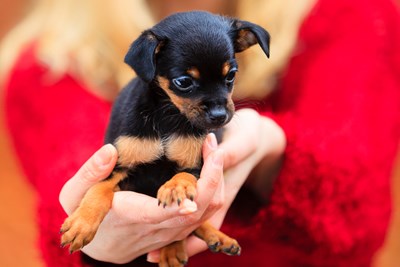Adopting a rescue dog offers its own rewards and challenges. You have the chance to provide a forever-home to an animal that will love you unconditionally. However, you cannot be sure of a rescue dog’s past history. They are often used to a routine from another household, or they may have been abused. To make the transition as smooth as possible, read these 10 tips for adopting a rescue dog.
- Be prepared to pay.
Adopting a dog from a rescue can cost a nice chunk of change. The fee can be anywhere from $50 to $500, based on the breed and where the dog is coming from. This adoption fee is usually a way to recoup the money the organization spent to keep the dog happy and healthy. - Determine the dog’s health.
Determining the health of a dog may not be an easy task. The first thing you should do is look the dog over. If he or she looks hurt or unhealthy in any way, consider avoiding the adoption. External signs of poor health could mean the dog has other problems internally. If possible, ask for the number of the vet the owner uses so you can find out more about the dog’ health history. If not, ask if you can take the dog to the vet before you adopt. - Be available upon adoption.
Ideally, you should be able to stay home with your new dog for a few days after adopting him or her. During this time, your presence will help ease the tension the dog feels due to being in a new place. You will also be able to implement rules, supervising your dog as he or she becomes accustomed to these new rules. - Limit your dog to one room.
Before allowing your dog to explore the entire house, limit him or her to a single room or area. Keeping the dog in one area allows the dog time to acclimate to this area and to the sights and smells of a new home. Spending time with him or her will help adjustment during this time. - Expect accidents.
Because your dog is in new surroundings, he or she is not yet familiar with the routine. Accidents may happen and could happen regularly. Consistency is the key to creating and maintaining a routine. Start taking your pet out several times a day and narrow the trips outside down to certain times that are convenient for you. - Avoid house guests.
For the first few days of having your new dog at home, you’ll want to avoid having guests over. Before you introduce new people, your pet should adjust to you and your family. Visitors can disrupt this adjustment. If guests cannot be avoided, ask them to not pay attention to your dog until he or she has calmed down. - Maintain consistent rules.
Once you start a rule, do not break this rule. Ever. Dogs need structure to be happy. If you allow rules to be broken, the dog may become difficult to train in other situations. Praise your dog for good behavior. It may be difficult at first, but eventually he or she will become more comfortable with the rules. - Anticipate misbehavior.
The best way to avoid problems is to anticipate them. During the first few weeks, avoid problems ahead of time. Remove tempting things to chew like shoes, clothes, or children’s toys. Remove any rugs from the floor that he or she may “go” on. Finally, encourage your pet when they do behave by giving occasional treats. - Consider obedience training.
Soon after getting a new dog, consider obedience training. This training may be available through a store such as PetSmart or through some cities’ Parks and Recreation Department. Obedience training is a six- to eight-week class that takes one hour a week. This training will teach your dog to obey you, and you may learn better training methods. - Realize the adjustment period varies.
Some dogs become adjusted to their surroundings within a week or two. Some may take a couple of months. While it may be difficult, remember that your pet is in a new, strange environment, and is unsure of his or her surroundings. Give your dog time to get used to his or her environment with as little stress as possible. Stress will only scare your dog and may cause regression.



